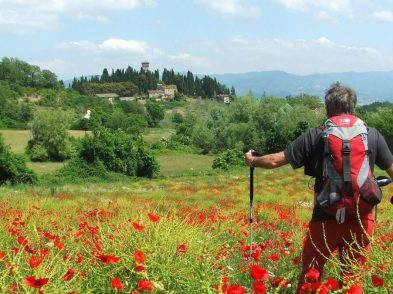In central Italy, where Umbria, Romagna and Tuscany meet, there is a valley called Valtiberina, a borderland where the Tiber river begins. It was here that Andrea Pichi, a man from a prominent family with centuries-strong ties to the region, launched one of Tuscany’s few contemporary cigar brands not so long ago. But the tobacco economy’s current uptick is a revival, not a novelty—it first took root in the Valtiberina in the days of Caterina de’ Medici.
Bride to the King of France, Caterina was said to suffer from headaches. French ambassador to Portugal Jean Nicot—from whose name we derive the word “nicotine”—knew that the King of Spain relied on the tobacco plant to alleviate his own headaches, so he set off to Spain to obtain the seeds for his queen. The Queen’s bishop, Nicolò Tornabuoni, caught wind of the seeds and shared them with his uncle, the bishop of San Sepolcro, the largest town in Valtiberina.
It was a prosperous time in the Valtiberina, due to substantial production of azure textiles in the area, which were then sold in Florence. The tobacco market would also go on to flourish, largely for political reasons.
Valtiberina was the site of the now-defunct Republic of Cospaia. “The Republic was born in 1441 due to a cartographical error between the Gran Duchy of Tuscany and the Papal states,” explained Elisa Duranti, a tour guide for the Museum of Tobacco in nearby San Giustino. “Piero della Francesca on the Tuscan side and his understudy Fra Luca Pacioli on the Papal side both failed to include the stretch of land between the streams Rio della Gorgaccia and Riascone on their respective maps.” Thus, the citizens of Cospaia took advantage of this mistake and declared independence.
That is the official version of the story. But Andrea Pichi recounts a different one.
In 1441, his family needed salt to fix the dye for the textiles they were producing. The problem was that the nearest salterns were located in Cervia, which was part of the Papal States, and a tariff had to be paid to bring it over. (Again, Valtiberina was and is a borderland). The Pichi family controlled territories from Badia Tedalda all the way to Montauto, towards Arezzo, beyond the Castello di Sorci. In an agreement with the Papal States and with the Medici, the Republic of Cospaia, the first Italian republic, was born.
“They say it was due to a cartographical error, but on our side, we had Piero Della Francesca tracking the borders, an artist and mathematician, and on the Papal side there was his understudy, Fra Luca Pacioli, inventor of the double entry bookkeeping system. I don’t find it likely that two renowned mathematicians would be unable to agree on a border. It is obvious that all of this was made with the placet of the two neighbouring powers.”
The Republic of Cospaia, with no written laws, prospered for 400 years as a sort of proto-Liechtenstein. It was an important center for agriculture, and sold its merchandise tax-free to neighbouring states. From 1570, this was the area where tobacco production bloomed in Italy, since in most places in Europe, where the influence of the church was considerable, the price for cultivating products from the new world was excommunication. The Pichi countess, fascinated by the flower of the tobacco plant— a petunia— began cultivating it for ornamental purposes, while the family continued the cultivation of woad, the source of blue dye prior to the introduction of the indigo plant. San Sepolcro eventually became the center for tobacco plant cultivation in Tuscany, and it would get shipped to Florence, where the cigars were fabricated.
According to Andrea Pichi, the Tuscan cigar in its current form emerged from what he calls a “sliding door” scenario. A shipment of tobacco was on its way from Valtiberina to Florence, already dried and treated. During the trip, a summer storm hit the shipment, and upon delivery, it was completely soaked. The idea of throwing it away was discussed, but the warehouseman thought it would be a waste and decided to try to dry it. That was the second fermentation, which is now standard practice. Once on the market, this tobacco sold exceedingly well, with requests piling up even after it ran out. Eventually it replaced the customary product. “That was the birth of the Tuscan cigar,” says Pichi.
Tuscany’s only other major handmade cigar company is in Lucca, and Pichi says pointedly, “We make everything here in Valtiberina.” The company’s cigars are handmade by a team of sigaraie, a further element of production aligned with tradition, since the wrapping of cigars was long considered a women’s job. The cigars being wrapped today are made with the harvest from the previous year. Not only does the treatment last a year, but the cigars are aged for a minimum of six months to a year and a 16 month-aged version is in the works.
The Republic of Cospaia ceased to exist in 1826, being absorbed into the Papal States. Each citizen of the Republic received a silver coin as an incentive to continue the production of tobacco. Compagnia Toscana Sigari carries on the tradition of black tobacco today, charging forward with the Pichi family business and the Valtiberina’s legacy. As Andrea Pichi likes to put it, “We are like Cheval Blanc in Bordeaux. We have the territory, and the others don’t.”







